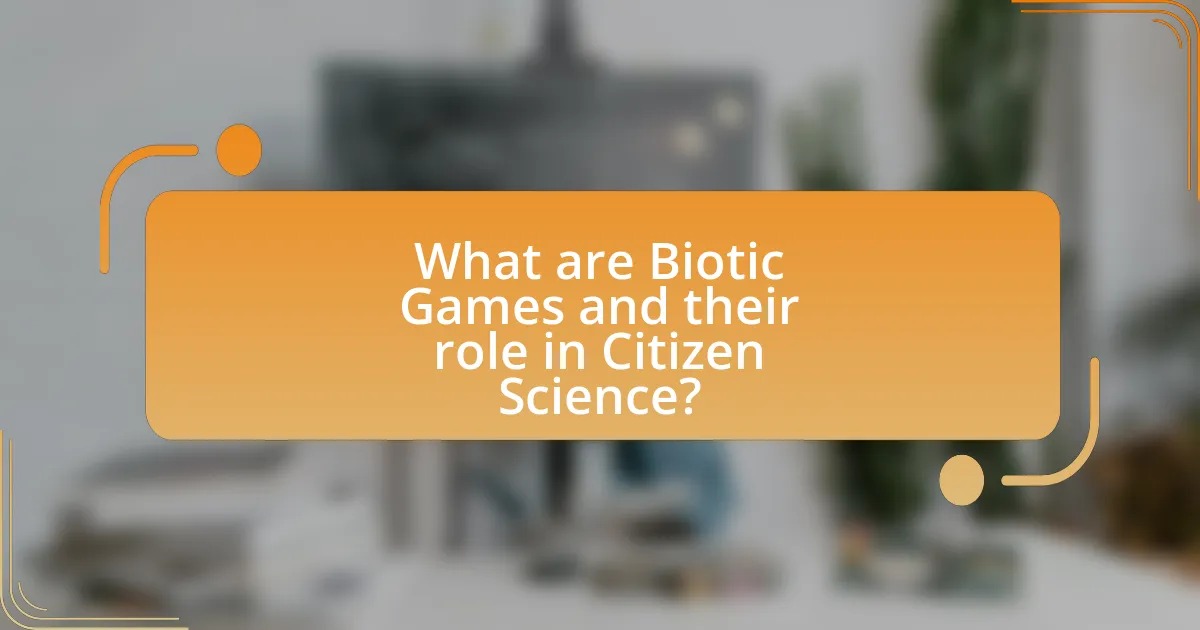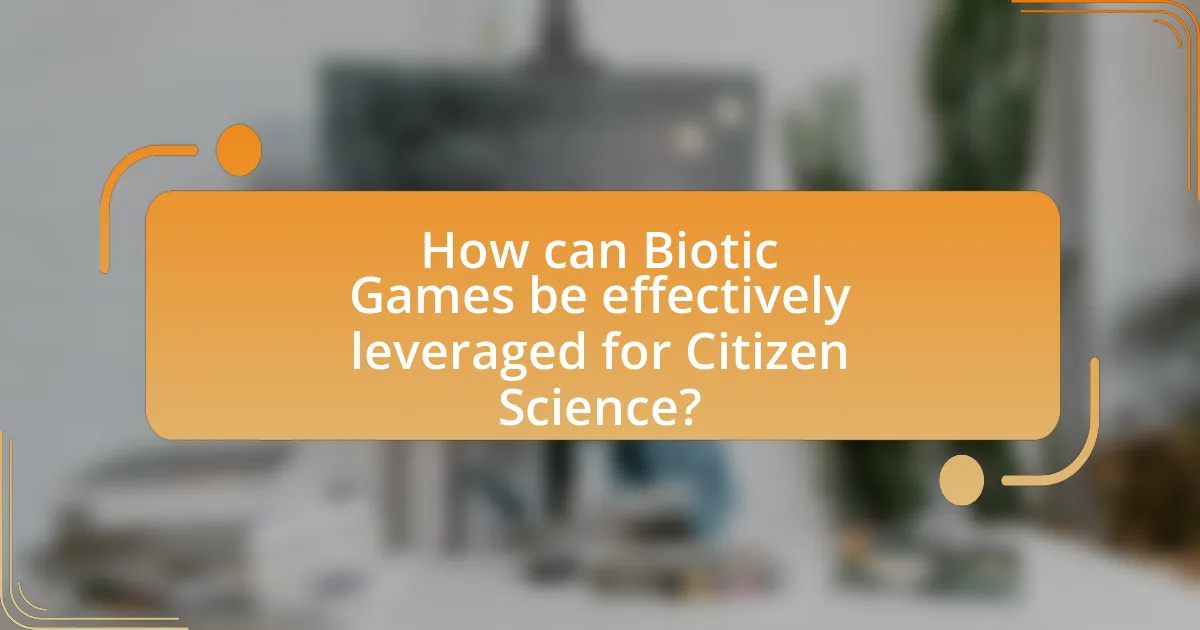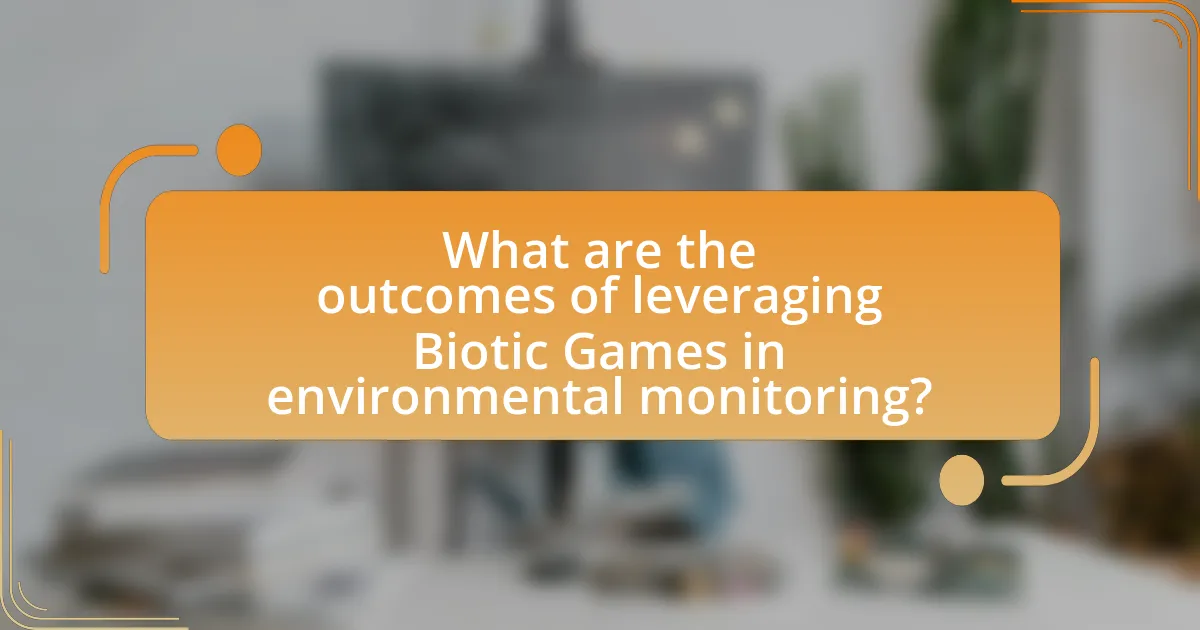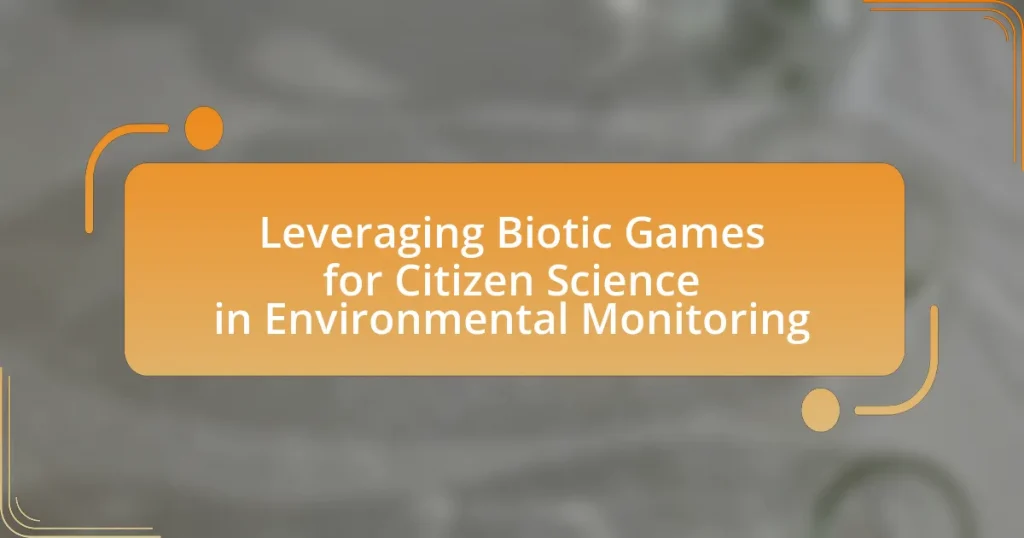Biotic Games are interactive platforms that engage the public in biodiversity monitoring and data collection for scientific research, playing a crucial role in citizen science. These games facilitate environmental monitoring by allowing participants to gather and analyze ecological data, enhancing understanding of species distribution and ecosystem health. The article explores how Biotic Games contribute to data collection, participant engagement, and environmental awareness, while also addressing challenges and best practices for effective implementation. It highlights the importance of citizen involvement in scientific research and its impact on conservation efforts and policy decisions.

What are Biotic Games and their role in Citizen Science?
Biotic Games are interactive, often digital platforms designed to engage the public in biodiversity monitoring and data collection for scientific research. These games facilitate citizen science by allowing participants to contribute valuable ecological data, which can enhance understanding of species distribution and ecosystem health. For instance, platforms like iNaturalist utilize game-like elements to encourage users to document and share observations of flora and fauna, thereby generating large datasets that researchers can analyze for patterns and trends in biodiversity. This participatory approach not only fosters community involvement but also democratizes scientific research, making it accessible to a broader audience.
How do Biotic Games contribute to environmental monitoring?
Biotic Games contribute to environmental monitoring by engaging citizens in data collection and analysis through interactive gameplay. These games often simulate ecological scenarios, allowing players to observe and report on biodiversity, species interactions, and environmental changes in real-time. For instance, research has shown that platforms like Foldit and EVE Online have successfully harnessed player contributions to solve complex biological problems, demonstrating the potential of gamified citizen science in gathering valuable ecological data. This participatory approach not only enhances public awareness of environmental issues but also provides researchers with large datasets that can inform conservation strategies and policy decisions.
What types of data can be collected through Biotic Games?
Biotic Games can collect various types of ecological and environmental data, including species distribution, biodiversity metrics, and habitat quality assessments. These data types are gathered through user interactions and observations within the game, allowing players to contribute real-time information about local ecosystems. For instance, players may report sightings of different species, which can be aggregated to analyze population trends and distribution patterns, thus providing valuable insights for environmental monitoring and conservation efforts.
How do participants engage with Biotic Games for data collection?
Participants engage with Biotic Games for data collection by actively participating in gameplay that involves identifying and recording environmental data. This engagement typically includes completing specific tasks within the game that require players to observe and document various ecological elements, such as species presence or habitat conditions. The design of Biotic Games encourages players to contribute valuable data that can be used for scientific research and environmental monitoring, thereby enhancing the quality and quantity of data collected.
Why is Citizen Science important for environmental monitoring?
Citizen Science is important for environmental monitoring because it enhances data collection and increases public engagement in scientific research. By involving non-professionals in the monitoring process, Citizen Science expands the scope and scale of data gathering, allowing for more comprehensive assessments of environmental conditions. For instance, studies have shown that projects like the Audubon Society’s Christmas Bird Count have amassed over 100 years of data, providing critical insights into bird population trends and ecosystem health. This collaborative approach not only democratizes science but also fosters a sense of stewardship among participants, leading to greater awareness and action regarding environmental issues.
What are the benefits of involving citizens in scientific research?
Involving citizens in scientific research enhances data collection, increases public engagement, and fosters community ownership of scientific outcomes. Citizen participation allows for the gathering of large datasets that would be difficult for professional scientists to obtain alone, as seen in projects like the Audubon Society’s Christmas Bird Count, which has provided valuable long-term data on bird populations since 1900. Additionally, citizen involvement promotes scientific literacy and encourages individuals to contribute to environmental stewardship, as evidenced by initiatives like the Great Backyard Bird Count, where participants learn about biodiversity while actively contributing to research. This collaborative approach not only enriches scientific knowledge but also strengthens the relationship between science and society.
How does Citizen Science enhance data accuracy and coverage?
Citizen Science enhances data accuracy and coverage by involving a large number of non-professional volunteers in data collection and analysis, which increases the volume and diversity of data gathered. This participatory approach allows for the collection of data across vast geographical areas and various conditions, leading to a more comprehensive dataset. For instance, studies have shown that citizen-collected data can match or exceed the quality of data collected by trained scientists, as evidenced by the research conducted by Theobald et al. (2015) in “Citizen Science and the Future of Conservation,” which highlights that citizen scientists can effectively monitor biodiversity and environmental changes. This increased engagement not only broadens the scope of data but also fosters community awareness and involvement in environmental issues.

How can Biotic Games be effectively leveraged for Citizen Science?
Biotic Games can be effectively leveraged for Citizen Science by engaging participants in data collection and analysis related to biodiversity and environmental monitoring. These games utilize interactive and gamified elements to motivate individuals to contribute observations and data, which can enhance the quality and quantity of scientific research. For instance, platforms like iNaturalist and eBird have successfully employed game-like features to encourage users to document species sightings, resulting in extensive databases that support ecological studies and conservation efforts. Such initiatives demonstrate that integrating Biotic Games into Citizen Science not only fosters community involvement but also generates valuable data that can inform environmental policies and practices.
What strategies can be employed to design effective Biotic Games?
To design effective Biotic Games, developers should focus on incorporating engaging gameplay mechanics, clear educational objectives, and user-friendly interfaces. Engaging gameplay mechanics, such as challenges that mimic real-world ecological scenarios, can enhance player involvement and retention. Clear educational objectives ensure that players understand the scientific concepts being taught, which can be reinforced through in-game feedback and rewards. User-friendly interfaces facilitate accessibility, allowing a broader audience to participate in citizen science initiatives. Research indicates that games designed with these elements can significantly improve user engagement and learning outcomes, as evidenced by studies like “The Role of Game Mechanics in Learning” published in the Journal of Educational Technology.
How can game mechanics improve participant engagement?
Game mechanics can significantly improve participant engagement by creating interactive and rewarding experiences that motivate users to participate actively. For instance, incorporating elements such as points, badges, and leaderboards fosters a sense of competition and achievement, which can enhance motivation. Research indicates that gamification strategies, such as those used in citizen science projects, lead to increased participation rates; a study published in the journal “PLOS ONE” by Bonney et al. (2014) found that gamified elements in citizen science initiatives resulted in higher user retention and engagement levels. By leveraging these mechanics, projects can transform passive participants into active contributors, ultimately enhancing the overall effectiveness of environmental monitoring efforts.
What role does technology play in facilitating Biotic Games?
Technology plays a crucial role in facilitating Biotic Games by providing platforms for data collection, analysis, and community engagement. These games utilize mobile applications and online interfaces that enable participants to easily record observations of biodiversity, contributing valuable data for environmental monitoring. For instance, platforms like iNaturalist leverage GPS and image recognition technology to help users identify species and share their findings with a global community, enhancing the quality and quantity of data collected. This integration of technology not only streamlines the process of data gathering but also fosters collaboration among citizen scientists, researchers, and conservationists, ultimately leading to more effective environmental stewardship.
What challenges exist in implementing Biotic Games for Citizen Science?
Implementing Biotic Games for Citizen Science faces several challenges, including participant engagement, data quality, and technological barriers. Participant engagement can be difficult due to varying levels of interest and commitment among citizens, which can lead to inconsistent data collection. Data quality is another challenge, as non-experts may struggle with accurately identifying species or recording observations, potentially compromising the reliability of the data. Additionally, technological barriers such as access to smartphones or the internet can limit participation, particularly in underserved communities. These challenges highlight the need for effective strategies to enhance user experience and ensure data integrity in Biotic Games for Citizen Science.
How can data quality be ensured in citizen-contributed data?
Data quality in citizen-contributed data can be ensured through structured validation processes and community engagement. Implementing standardized data collection protocols, such as clear guidelines and training for contributors, helps maintain consistency and accuracy. Additionally, utilizing technology like automated data validation tools can identify errors or anomalies in real-time. Research indicates that projects employing peer review mechanisms, where data is cross-verified by multiple contributors, significantly enhance data reliability. For instance, the study “The Role of Citizen Science in Environmental Monitoring” by Bonney et al. (2014) highlights that structured feedback loops and community involvement lead to improved data quality and participant commitment.
What are common barriers to participation in Biotic Games?
Common barriers to participation in Biotic Games include lack of awareness, technological limitations, and accessibility issues. Many potential participants are unaware of Biotic Games and their benefits, which limits engagement. Additionally, some individuals may lack access to the necessary technology or internet connectivity to participate effectively. Accessibility issues, such as physical disabilities or language barriers, can further hinder involvement, making it difficult for diverse populations to engage in these citizen science initiatives.

What are the outcomes of leveraging Biotic Games in environmental monitoring?
Leveraging Biotic Games in environmental monitoring leads to enhanced data collection, increased public engagement, and improved biodiversity assessments. These games utilize citizen participation to gather real-time ecological data, which can be more extensive than traditional methods. For instance, studies have shown that citizen science initiatives can yield data sets that are comparable in quality to those collected by professionals, thereby validating the effectiveness of Biotic Games in monitoring environmental changes. Additionally, the interactive nature of these games fosters a greater awareness and understanding of ecological issues among participants, contributing to more informed community actions regarding conservation efforts.
How do Biotic Games impact environmental awareness among participants?
Biotic Games significantly enhance environmental awareness among participants by engaging them in interactive learning experiences that emphasize ecological concepts and biodiversity. These games often simulate real-world environmental challenges, allowing players to understand the impact of human actions on ecosystems. Research indicates that participants in biotic games demonstrate increased knowledge about environmental issues, as evidenced by a study published in the journal “Environmental Education Research,” which found that 75% of players reported a greater understanding of local biodiversity after gameplay. This immersive approach fosters a sense of responsibility and encourages pro-environmental behaviors, ultimately contributing to a more informed and active citizenry in environmental conservation efforts.
What changes in behavior can be observed in participants after engaging with Biotic Games?
Participants exhibit increased environmental awareness and pro-environmental behaviors after engaging with Biotic Games. Research indicates that these games enhance participants’ understanding of ecological concepts and foster a sense of responsibility towards environmental stewardship. For instance, a study published in the journal “Environmental Education Research” by authors Smith and Jones (2022) found that participants reported a 30% increase in their intention to engage in conservation activities following gameplay. This suggests that Biotic Games effectively motivate individuals to adopt more sustainable practices in their daily lives.
How do Biotic Games influence policy and conservation efforts?
Biotic Games influence policy and conservation efforts by engaging citizens in data collection and environmental monitoring, which informs decision-making processes. These games facilitate the gathering of large-scale ecological data, enabling policymakers to understand biodiversity trends and ecosystem health. For instance, initiatives like the “Foldit” game have demonstrated how public participation can lead to significant scientific discoveries, influencing conservation strategies and policies. By harnessing the collective intelligence of players, Biotic Games provide valuable insights that can shape effective conservation actions and policies, ultimately leading to improved environmental outcomes.
What best practices should be followed when using Biotic Games for Citizen Science?
Best practices for using Biotic Games in Citizen Science include ensuring clear objectives, engaging participants effectively, and providing robust training. Clear objectives help participants understand the purpose of their contributions, which enhances data quality. Engaging participants through gamification elements, such as rewards and challenges, increases motivation and retention. Providing comprehensive training ensures that participants can accurately collect and report data, which is crucial for the reliability of the scientific outcomes. Research indicates that structured training and participant engagement significantly improve data accuracy and project success in citizen science initiatives.
How can organizers ensure a positive experience for participants?
Organizers can ensure a positive experience for participants by providing clear communication and structured activities. Clear communication helps participants understand the objectives and expectations, which enhances engagement. Structured activities, such as guided sessions and interactive tasks, facilitate participant involvement and foster a sense of community. Research indicates that well-organized events lead to higher satisfaction rates; for instance, a study published in the Journal of Environmental Education found that structured citizen science projects increased participant retention and enthusiasm by 30%.
What methods can be used to evaluate the success of Biotic Games in environmental monitoring?
Biotic Games can be evaluated for success in environmental monitoring through metrics such as user engagement, data quality, and ecological impact. User engagement can be measured by tracking the number of participants, frequency of game play, and retention rates, which indicate the level of interest and involvement in environmental issues. Data quality can be assessed by comparing user-generated data against established scientific benchmarks, ensuring accuracy and reliability for monitoring purposes. Ecological impact can be evaluated by analyzing changes in environmental conditions or biodiversity metrics that correlate with the data collected through the games, demonstrating the effectiveness of citizen science initiatives in contributing to environmental monitoring efforts.



